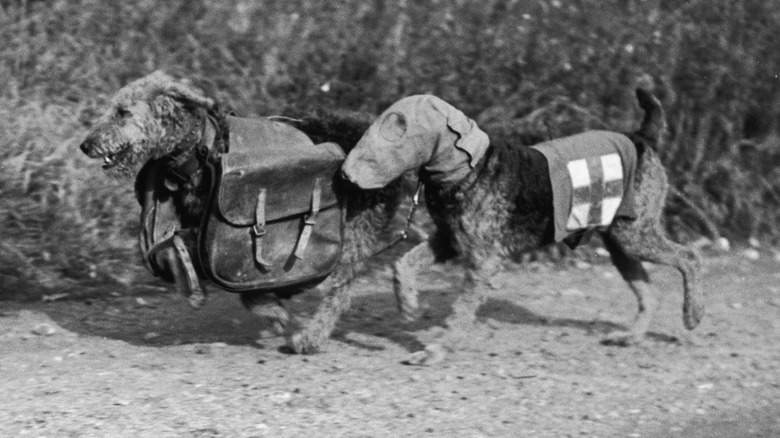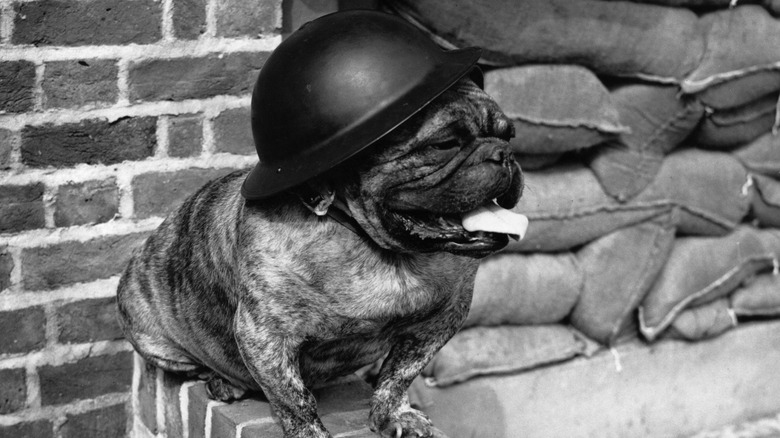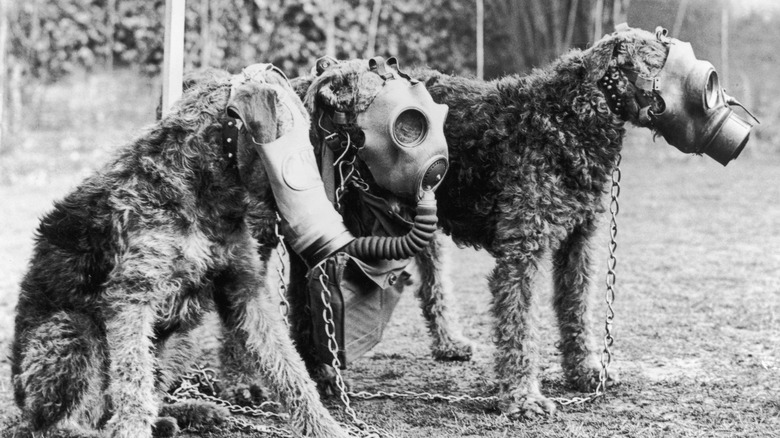How The Military Used Dogs As Anti-Tank Weapons
Dogs play a large part in our lives. Not only are they faithful companions as our pets, but some canines have been integral to people's professions. From St. Bernards carrying warmed whiskey to victims caught in an avalanche to bomb-sniffing dogs, the most loyal animal has been by our side for millennia.
There have even been moments in human history when dogs have been by our side in times of great conflict and war. Indeed, soldiers and armies brought along dogs to protect supplies, according to National Archives. For example, around 20,000 dogs served in the U.S. Army, Coast Guard, and Marine Corps in World War II. But at some point, during that same war, dogs had a far more dangerous job: stopping tanks. Okay, hold up, yes, tanks. According to Russia Beyond, the Russians were so desperate to fight against German fighters that they employed their canine buddies to stop their advance.
Dogs, of course, are not the only animals to be in the frontlines of battle. In both World War I and II, horses were used as beasts of burden — aka to carry supplies — and as part of the cavalry. The First World War even saw a heroic carrier pigeon that helped turn the tide of a battle; rest in peace and thank you Cher Ami. But dogs, in particular, can serve many tasks. Other than guarding supplies, Army History wrote canines were also trained to patrol areas around camps and battlegrounds, and, in some cases, kill enemy soldiers.
But again, tanks?
Not the best training method
As explained by Russia Beyond, it wasn't like the Russian army had much of a choice during World War II — they knew their weapons could only hold off the Nazis for so long. So in advance of a potential invasion, they looked for other means to defeat their enemies.
The Russian army decided to train dogs to sniff out enemies in the 1930s. The dogs were taught to crawl under tanks while carrying around 26 pounds of dynamite on their backs. You can probably guess where this is going. Once underneath, the dog's handler will then pull a long lever to set off the explosives. The heroic canines earned the nickname "suicide dogs" because of the sacrifice they undertook.
By today's standards, not only is the assignment gruesome, but the training program was definitely not the most humane method of teaching tricks. In order to train the dogs to crawl under tanks, they were starved for several days, and then pieces of meat were placed underneath the vehicles. Hungry, the dogs would creep below the vehicles. Over time, the dogs associated tanks with the idea of food and would slither under without question. Another method was teaching the dogs not to be scared of heavy artillery, so they would run towards a tank in hopes of avoiding bullets from a machine gun. The first few anti-tank dogs were introduced into the Russian army in 1939 but were not used until 1941.
Early disaster
By 1941, Axis forces began advancing towards Moscow. But the first battle with the special unit of anti-tank dogs and their human handlers (Russia Beyond said it consisted of 212 dogs and their 199 trainers) did not go so well. First, the dogs had no cover from the army, so the Nazis quickly shot the poor animals. The dogs also trained with Russian tanks, which ran on diesel. Axis tanks used gasoline, so the dogs did not recognize the smell of the tanks and thus were very confused on the battlefield. Eventually, the battalion was overwhelmed and captured.
Undeterred, the Russians changed up their training methods a little. By the end of 1941, more than 1,000 anti-tank canines had been deployed, and the number doubled the following year. Soon, the experiment began taking fruit. The dogs were taking down tanks left and right to the point that their actions turned the tide during a battle in July 1942.
The Russians also began training dogs to bomb other targets. As a result, they managed to blow up enemy fortifications, munitions depots, and bunkers. Dogs were even credited with helping the Russians defeat the Germans during the Siege of Leningrad when the Nazis were forced to flee. However, the Russian army finally got stocks of anti-tank weapons soon after, freeing up the dogs from serving out their gruesome fates. They were instead retrained to sniff out mines. The good news is many of the dogs lived long, happy lives after the war.


